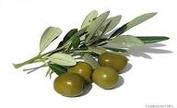
Unlike many wines, which improve with age, extra virgin olive oil is perishable; like all natural fruit juices, its flavor and aroma begin to deteriorate within a few months of milling, a decline that accelerates when the oil is bottled, and really speeds up when the bottle is opened and exposed to the air.
When choosing bottled oil, look for a dark glass or other containers that protect against light, buy a quantity that you’ll use up quickly, and keep it well sealed in a cool, dark place. Even an excellent oil can rapidly go rancid when left sitting under a half-bottle of air, or in a hot or brightly-lit conditions.
Don’t pay much attention to the color of an oil. Good oils come in all shades, from vivid green to gold to pale straw, and official tasters actually use colored glasses to avoid prejudicing themselves in favor of greener oils. Both in flavor and aroma, genuine extra virgin oils have, a marked fruitiness reminiscent of fresh olives, and typically have some level of bitterness and pungency (peppery at the back of the throat). In great oils these characteristics are harmoniously balanced, together with complex aromas, flavors and after tastes.
Don’t be put off by bitterness or pungency – remember that these are usually indicators of the presence of healthful antioxidants, anti-inflammatories and other healthful “minor components” of top-quality olive oil – unless one of these characteristics is overwhelming in flavor compared to the other flavors.
1. Extra Virgin Olive Oil
Extra Virgin olive oil is totally free from defects, which are caused by the olives fermenting and going rancid. Extra virgin olive oil is under 1 percent acidity, and has a very positive taste to it - buttery and fruity.
2. Virgin Olive Oil
Virgin oil is allowed to have trace elements of defect in it. It does not score as high on a fruity level and can have a higher acidity.
3. Olive Oil
Ordinary olive oil is what most people buy. It has a higher level of impurity in it and frequently doesn't have a fruity taste at all. It's inexpensive because it's produced from lower quality olives.
Read the label if you aren’t able to taste the oil or get help from a knowledgeable salesperson, you’ll have to rely on the label for information about the oil. To begin with, be sure your oil is labeled “Extra Virgin,” since other categories – “pure” or “light oil",– have undergone chemical refinement which strips away the olives flavor and many of the oil’s health benefits.
To ensure freshness, look for bottles with a “best by” date, or a "date of harvest" indicated. Try to buy oils only from this year’s harvest. “Best by” dates are usually two years from the time an oil was bottled, so if you see a date that is two years away, the oil is more likely to be fresh. Phrases like “packed in Italy” or “bottled in Italy,” do not mean that the oil was made in Italy, much less that it was made from Italian olives. Italy is one of the world’s major importers of olive oil, much of which originates in Spain, Greece, Tunisia and elsewhere, so don’t be taken in by Italian flags and scenes from the Tuscan countryside on the packaging. Some of the oil imported into Italy is consumed by Italians, but much of it is blended, packed and re-exported.
Cooking With Olive Oil
- Once you’ve bought your oil, store it in a place where it's protected from light, heat and oxygen, the three enemies of good oil, which speed spoilage. And don’t hoard it! Even great oils deteriorate with each passing day, and will all too soon become ordinary, even rancid, if not used quickly.
- There is a great deal of disagreement, and a fair bit of misinformation, concerning whether to use extra virgin olive oil, rather than refined (“pure,” “light”) olive oil for frying. Quality extra virgin olive oil is a fine choice for sauteing and shallow frying, so long as its flavor doesn’t overpower the food; an aggressive early-harvest oil would be a poor choice to saute fish, for example. Using extra virgin olive oil for deep-fat frying at higher temperatures is uneconomical, and can even be counter-productive, because the cooking process can accentuate the harsh flavors in the oil, and many of the flavors and aromas of fine oils will volatilize and disappear. Refined olive oil is probably a better choice for deep-fat frying, though there are undoubtedly many extra virgin olive oils that hold up well to frying – the lower an oil’s free fatty acidity, the higher its smoke-point (the temperature at which it begins to smoke, producing unpleasant and unhealthful byproducts), and the more times it can be re-used. (Each time the oil is heated it's acidity rises, meaning that its smoke point will and quality will both decline.)
- Depending on their composition, most oils harden when chilled. As they cool, a waxy sediment settles out of them. Freezing does not harm an oil – in fact, it is a good method of preservation – but may reduce its shelf life if substantial sediment is produced.
Sources:
Olive Oil Source
The Truth In Olive Oil
Olive Oil Times
 RSS Feed
RSS Feed
